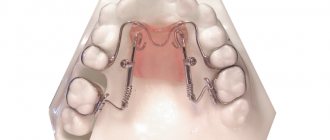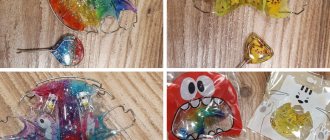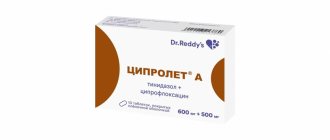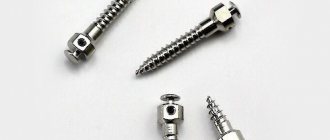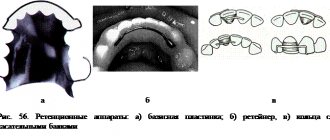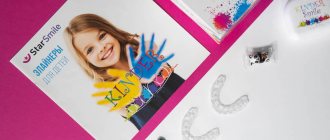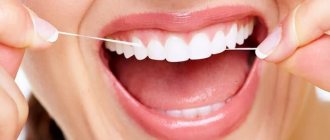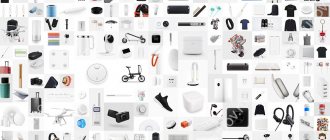Orthodontic treatment necessary to correct the bite and incorrect position of the teeth is not only braces, the main period of use of which is the period of permanent dentition. In temporary and temporary dentition, as well as in cases of diseases of the hard tissues of teeth, allergic reactions to metal, as a rule, removable appliances that are structurally simpler, but very effective in their indications, are used. As the name suggests, such structures can and even need to be removed while eating and brushing your teeth, and this is their significant advantage. The method of fixing removable orthodontic appliances in the mouth is as simple as possible, and quick adaptation creates additional ease of use for patients.
Treatment mechanism
Removable orthodontic appliances are divided into devices:
1 . Mechanical action - influence the teeth and dentition through mechanical elements. These are different types of plate devices.
2. Functional action. - regulate impaired functions that affect the formation of bite, and due to this prevent or eliminate the development of dental anomalies. This group includes trainers, function regulators, and individual functional devices.
3. Combined - combines mechanical and functional properties at the same time.
Removable orthodontic appliances of standardized systems are selected by the doctor according to size, rigidity and other parameters, while individual ones are made from impressions in a dental laboratory. Most often, such structures are used in childhood and adolescence, helping the jaws to form in the desired closure. Thanks to this, permanent teeth are able to grow in the correct, physiological position. In adults, these structures can be used as additional methods in correcting malocclusion.
Removable orthodontic appliances primarily eliminate the causes of malocclusion, allowing the teeth to return to their place on their own. Plates and trainers also solve other problems: they improve the functions of speech, breathing and swallowing, correct the position of the tongue, and reduce the pressure of the jaw muscles on the teeth. Often they are indispensable in order to consolidate the results of treatment with braces.
Timely treatment with removable appliances for correcting occlusion at the stages of temporary and mixed dentition can prevent the development of malocclusions, facilitate and shorten the treatment time for this disease during the period of permanent dentition.
Often, timely treatment during the period of temporary and mixed dentition leads to the formation of a correct permanent dentition.
Classification of orthodontic appliances by place of support
Reciprocal devices.
Reciprocal support allows you to use the counterforce simultaneously to fix the apparatus and move the teeth.
Stationary supports (teeth displacement is not allowed).
To select the right support, the doctor determines the diagnosis, taking into account not only the condition of the jaw, bite and number of teeth, but also the general health of the patient. Correctly selected support allows you to completely eliminate any orthodontic defects.
Kinds
Aligner aligners . These lightweight, clear, biopolymer trays are placed over teeth to correct minor malocclusions or consolidate the results of more serious treatment. They are made individually using digital impressions and digital modeling, which allows one to accurately predict the fit and the result of further work. Aligner aligners can change the position of one or more teeth, realigning them into the dentition and positively influencing the bite.
Records . Removable orthodontic devices of a mechanical type. They consist of a plastic biocompatible base on which mechanical elements (springs, screws, arcs) are installed. They can move both individual teeth and affect the shape of the dentition.
Thanks to the plates, the following orthodontic problems can be solved:
- correct the shape of the jawbone,
- stimulate or inhibit jaw development,
- prevent teeth from moving in the wrong direction,
- adjust the width of the sky,
- keep teeth in the desired position to secure a physiological bite.
You can correct your bite with plates from the age of 6-7 to 12-13 years, that is, during the period when baby teeth are replaced by permanent teeth. At this time, the dental system is actively growing, and this process can be easily influenced without braces. Typically, children quickly adapt to removable appliances, and bite correction is comfortable. In addition, plates are less noticeable on the teeth than braces.
Trainers . These are elastic silicone devices that help eliminate the very causes of malocclusion and are shown:
- with an open or deep bite,
- crowding of the anterior incisors on the lower jaw,
- incorrect position of the lower jaw,
- nasal breathing problems,
- violation of the swallowing mechanism,
- to eliminate bad habits,
- to consolidate the results of treatment.
Trainers are useful because they “train” the jaw muscles to work properly. This prevents relapses, which sometimes occur after plates or braces. The trainer is worn at night and for 3-4 hours during the day. During sleep, the trainer normalizes breathing and swallowing functions and trains the tongue.
Other types of removable orthodontic appliances include various facial (outside the oral cavity) arches and masks, palatal clasps, and functional appliances. Each of them solves its own range of problems, correcting the position of teeth, training muscles, and setting the desired direction for jaw development.
Classification of orthodontic appliances by site of action
Extraoral. These include face bows and retention devices.
Face bows consist of three parts. The first, intraoral, is attached to the teeth. Two extraoral zones follow the shape of the head and end in hooks that provide extraoral traction. All parts are welded together. Cervical traction can be combined, high or cervical. The features of the devices depend on the diagnosis of the patients.
Intraoral
They in turn are divided into:
- single jawed,
- single-jaw intermaxillary action,
- two-jawed.
From their names it is clear where the devices are attached and in which direction they operate.
Wearing features and effectiveness
The main rule for using removable orthodontic appliances is to wear them regularly. The ability to remove structures is a temptation for children, so the child’s self-discipline and sufficient control on the part of parents are important in this matter. Depending on the type, removable orthodontic appliances must be worn from 12 to 24 hours a day. It should be stored in a special container that protects it from bacteria, and cleaned with a regular brush.
If you regularly wear plates, trainers or mouth guards for six months or more, strictly following your doctor’s recommendations, you can achieve lasting and very successful results.
Return to list of articles
Classification depending on fixation methods
Any orthodontic systems require long-term wear to achieve results. Sometimes they need to be put on for a couple of hours during the day, or at night, and sometimes they need to be left on for a year or more. The following types of devices are distinguished:
- Removable systems. They are most often used in children, or for adults - for minor malocclusions. Such devices are worn for a limited time, which is prescribed by the orthodontist. The most common option is to wear the system for 12 hours. This is very convenient, because such orthodontic appliances for children can only be worn at night, before bed, which will allow the child to maintain self-esteem and not be embarrassed by their peers.
- Fixed systems are installed for a long period, from six months or more. The most famous of these devices are braces. They cannot be removed or installed independently; only an orthodontist should do and adjust them.
- Combined systems. As is already clear from the name, their essence lies in the use of both removable and non-removable devices. For example, wearing braces is often combined with special bandages or orthodontic traction.
Pshizova Asiyat
Dentist-orthodontist
Braces
Fixed orthodontic structures. They are classified according to several defining characteristics:
- positioning location. They can be vestibular (fixed on the outer side of the dentition) and lingual (installed on the inner side);
- method of attaching the power arc to the bracket pads. They are divided into ligature (fastening using ligatures - plastic rings or wires) and non-ligature (attached with small clip-locks);
- material of manufacture. The most popular are metal and ceramic products.
According to experts, the following models are considered the most popular:
- lingual non-ligature metal: WIN, INCOGNITO;
- vestibular non-ligature metal: Damon Q, H4;
- vestibular non-ligature ceramic: Damon Clear;
- vestibular metal ligatures: Biomim, Victory;
- vestibular ligature ceramic: Advanced, Hype.
Indications and contraindications for bite correction
Indications:
- Incorrect location of dental elements (displacement or rotation around the axis)
- Crowded teeth
- Large interdental spaces
- Displacement of the jaws relative to each other
Contraindications:
- AIDS, HIV
- Tuberculosis
- Blood or bone diseases
- Oncology
- Diabetes mellitus and thyroid pathologies
- Serious mental disorders
Important: contraindications to orthodontic treatment are identified by a specialist according to the patient. Therefore, you should definitely inform your doctor if you have any health problems. The desire for ideal occlusion can result in deterioration of health for a person burdened with the listed diseases.
Possible options
After determining the type of pathology and the degree of its development, the patient is faced with the choice of using one of the possible devices.
Maxillary
When increasing the size of the upper jaw, it is recommended to use the following devices:
- Coffin spring system
It is a plastic base to which springs (double or single) are attached, in the shape of a circle, oval or S-shaped bend. Two fixing processes go to this structure. The size of the spring is determined by its type: a single spring is made from wires with a diameter of 0.8-1.5 mm, and a double one - 08.09 in the outer bend and 0.6-0.7 in the inner bend. The length for any type is the same - from 70 to 80 mm. The mechanism itself uses a springy property that allows the defect to be gradually corrected. The design is used at all stages of tooth development - milk, replacement and permanent. The main task is to expand the upper jaw arch. It is also used for shifts in the mesio-distal direction. In this case, the device should be placed with the more open part towards the rear.
If you need to enlarge the jaw in the lateral parts, a device with a double spring is used. It has activation features - approximately once every two weeks using spring extension.
- Devices with standard screw
This is also a kind of plate base, but there are no springs. They are replaced by a screw. If expansion of an entire jaw row is required, it is installed along the palate, and the necessary cutting is also made. In order for the elongation to occur smoothly, the device should be positioned at a right angle. For this purpose, secreted screws are installed at the fangs. The cut in this case is performed either perpendicularly or sectorally.
- Fan screw plates
This device is used much less frequently. Used to smoothly expand the anterior part of the jaw. If stretching is necessary for the entire length, symmetrical screws are used; if only on one side, asymmetrical screws are used.
Mandibular
The design that is used to lengthen the lower jaw is clearly different from the previous ones.
- With Koller spring
There are two types of these devices - for asymmetrical and symmetrical changes. The first design includes an arch that is located under the tongue. Two semicircular springs are attached to it, and two semicircular processes extend from them. In the second case, the basis of the structure remains the same, but has additions in the form of five springs in the shape of a semicircle (replacing the previous two). Let's look at the numbers: to produce the mechanism, wire 1.3-1.4 cm in length and 1.0-1.2 mm in diameter is used. Its curve is individual for everyone - so that when wearing it the frenulum of the tongue does not get affected. The size of the bends should not be more than 8.0 mm. The boundaries of the spring extend beyond the base, so there is no need to cover them with plastic. After this, the end of the wire is bent in the shape of a wave and passes next to the alveoli. The base itself should not reach the wire by 0.8-1.0 mm. If there are additional indications, the spring can be additionally bent into bends with a step width of 3.0-4.0 mm and up to 8.0 mm in length. They can be adjusted.
- With screw
This mechanism is used for installation above the lingual frenulum (in this case the cut is made vertically). If expansion of the lower jaw is required, two screws are attached to the apparatus and two vertical cuts are made. Their location depends on the fangs.
It is up to the doctor to decide which of the presented devices will be installed when correcting the bite. This is influenced by the neglect of the case, the condition of the teeth and tissues. Parameters such as duration of use of the structure and pressure force are calculated for each patient individually.
Aligners (aligners)
Aligners
– a progressive and quite comfortable method of correcting pathologies of the dental apparatus of minor and moderate severity. This is a transparent plastic product that is worn over the teeth. For each patient, several sets are individually manufactured, each of which differs from each other by a slight change in geometric parameters. The patient independently changes the aligners in accordance with the treatment regimen, the teeth gradually move into the desired position. The most relevant models are those specially designed for children and adolescents, for example, FlexiLigner (“flexics”) and KidsLight, as well as universal Invisaling aligners.
General overview
The mechanical type of these devices affects the bite due to the force that their construction provides (the muscles are not used). The formation of this force is facilitated by certain parts of the device, namely a screw, an inclined arc, a rubber rod and a spring. The most important role is played by pressure - its value is regulated by the orthodontist. In numbers, the value should be no more than 20 g/cm2 - this is just stable blood pressure in the capillaries. Due to constant stress, gradual deformation of teeth and bone tissue occurs. It is not recommended to increase the pressure - this can lead to pressure on the nerve endings. This may entail a decrease in the blood supply to the periodontal tissue, as well as become a source of necrosis with subsequent impairment of jaw mobility. If this happens, the device will have to be immediately removed and reinstalled, which will negatively affect the progress of treatment. Also, most mechanical devices are non-removable (the patient must wear them from the moment of installation until the end of the treatment procedure). Most often, devices are adjusted to a person’s parameters, and replacing them can throw the whole process back to the original stage.
Manufacturing cost
You can order the production of mechanical orthodontic correctors at most dental clinics. The cost of the service depends on many factors, but the average price list is as follows:
- A device equipped with a Coffin spring costs 15-17 thousand rubles;
- Analogue screw-type structures for the maxillary region - 14-16 thousand;
- Models with a fan-shaped propeller – from 20 thousand rubles;
- Products with a Koller spring - from 18 to 22 thousand;
- Screw devices for correction of the mandibular region - from 20 thousand rubles.
It should be taken into account that the course of treatment also involves additional costs, including initial and repeated consultations, laboratory diagnostics, anthropometric analysis and the production of a prototype based on the received impression or digital model, as well as work on installing and activating the device. The final cost is announced at the stage of agreeing on the treatment plan, which allows the patient to compare his own financial capabilities and determine the terms and method of payment.
Doctors note the effectiveness of mechanical devices on many pathologies of the dental system. A lot of positive feedback about these mechanisms also comes from patients who have undergone hardware treatment.
A.L.F.
A.L.F.
is a unique device for jaw development made from a special intelligent alloy in its design and functionality. A gentle effect on the bones of the skull according to the principle of osteopathy through cranial sutures allows you to gently remove blocks in the skull, returns natural breathing to the skull, normalizes the development of the facial skeleton, jaws, improves the general well-being of the patient, restores nasal breathing, works on development in the frontal and lateral parts of the jaw.
The device is worn constantly and is removed only during an appointment with the attending physician for activation. Activations approximately occur once every month to a month and a half. We begin to use the device from adolescence, and in adult patients, it can be installed on both the upper and lower jaw. Constant soft, springy action is ensured by the design and special alloy of the device. It is not fixed tightly to the teeth, but only rests on them. on the upper jaw, through the mucous membrane, it gently acts on the sutures that connect the bones of the upper jaw, with its help we can not only improve the aesthetics of the face, but also restore the correct volume of the jaw, create space for missing teeth, restore the correct position of the teeth, the correct volume of the jaw.
The duration of treatment varies from three to twelve months, depending on the complexity of the case. Oral hygiene deserves special attention while wearing the device. To prevent the development of caries, during the treatment period we recommend using additional hygiene products, in addition to brushes, brushes and special rinses.
Myogymnastics
This correction method is functional and involves training the facial and chewing muscles that keep the jaw system in the correct position. The exercises are effective when the child is between 3 and 5 years old. At an older age, myogymnastics is used as an additional method of correction, i.e., simultaneously with wearing removable or fixed orthodontic devices. The condition for the effectiveness of using the described method is the regularity of the exercises. Therefore, the main burden in treating young children falls on their parents.
Why is it important to correct your bite?
Aesthetic dental problems really complicate personal and business communication. But the main danger is that malocclusion is the cause of many diseases, and in order to avoid them, it is necessary to restore the proper functioning of the masticatory apparatus. Problems that a malocclusion leads to: improper distribution of the chewing load, which will accelerate tooth wear, contributes to the appearance of wedge-shaped defects, the formation of exposed roots, disruption of the temporomandibular joints, which leads to frequent headaches, muscle strain, spasms, hearing impairment, the appearance of unpleasant sounds in the ears and temporomandibular joints. Due to the complication of daily hygiene, the rapid development of caries, periodontitis, problems with diction arise, due to a lack of softening of food, diseases of the gastrointestinal tract appear. The atypical structure of the maxillofacial region, displacement of bones, jaws, and their inclinations lead to breathing problems, causing ENT diseases.
Everything in the human body is interconnected: a malocclusion usually entails poor posture.
Feeling good and having a harmonious face is worth visiting the dentist!
An important step in correcting a bite is diagnosis. Half of the success depends on correct and accurate diagnosis.
Device "Crozat"
The Crozat device is a soldered orthodontic device for the upper jaw and lower jaw, compact, soft, does not interfere with diction, stimulates the growth and development of the jaw. Used in complex treatment together with osteopathy, the treatment technique with the Crozat apparatus requires careful and precise activation, allows for symmetrical development of the jaw, restoring its correct volume, breathing of cranial sutures and bones, improving nasal breathing. The device is non-removable, is fixed in the oral cavity movably and is removed only at the moment of activation by the attending physician during the appointment. The wearing period varies from person to person, most often ranging from 6 to 9 months.
It is simply impossible to select a device on your own. The first step to a beautiful smile is scheduling a consultation with an orthocraniodontist.
"Twin-block" device
The Twin-Block device consists of two plates that correctly position the upper and lower jaws between each other. Used to treat mesial, distal and open bites. More often used in the treatment of the second skeletal class, deep overlap of the upper jaw with the lower jaw, when the lower jaw is located too posterior to the upper jaw, disrupting the bite, muscle function and facial aesthetics.
The design of the device includes the required number of screws and additional elements, based on the individuality of the case and its complexity. For the development of the jaws in their correct position, preventing the development of dysfunction of the temporomandibular joints, already in adolescence. It is used for children under 14 years of age, the device is worn around the clock, the treatment period takes 9-12 months. Food intake is also carried out in the apparatus, to enhance the effect and form correct skeletal growth.
Activation of the device and screws is carried out by the patient himself, and periodic visits to the doctor are necessary to correct the device, polish it, and monitor the patient’s well-being. The device is removable, but for constant wear, it is removed by the patient for the duration of oral hygiene and hygiene of the devices themselves.
Auxiliary elements
To perform additional actions, tubes, locks, hinges, buttons and other elements are used. The tubes help move the arc and are secured with screws. Locks are installed for brace systems, providing a reliable connection to the structure, free or rigid fixation. Lingual buttons are necessary for installing power elements. They are installed on the surface of the tooth using glue; externally, they are compact mushroom-shaped products that do not have a traumatic effect on the surrounding tissues.
How is the cost of orthodontic therapy determined?
The price of an occlusion correction course for different patients can vary significantly.
The final cost depends on the following factors:
- volume of diagnostic studies. Thus, diagnostics for therapy using aligners and plates are much cheaper than those when planning treatment using braces;
- the type of therapy chosen by the doctor (plates, aligners, braces);
- models of orthodontic apparatus. The cost of products may vary significantly;
- complexity of the clinical case. The more complex the defect, the longer the treatment will take.
